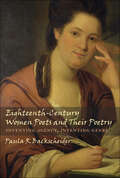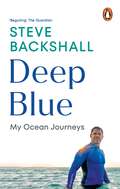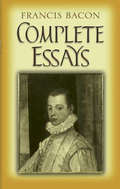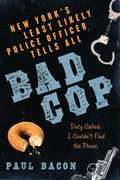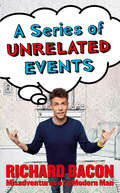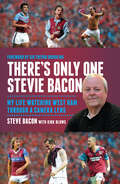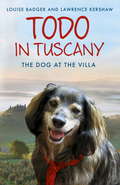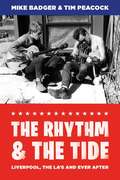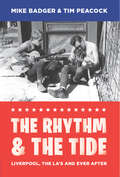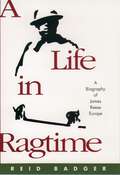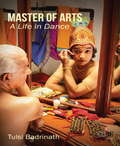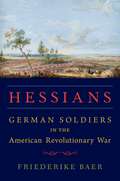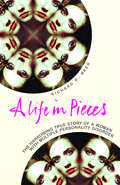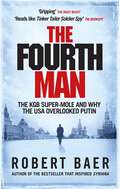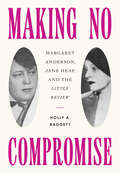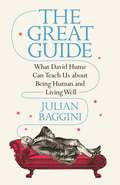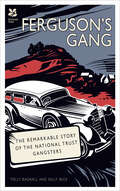- Table View
- List View
Eighteenth-Century Women Poets and Their Poetry: Inventing Agency, Inventing Genre
by Paula R. BackscheiderThis major study offers a broad view of the writing and careers of eighteenth-century women poets, casting new light on the ways in which poetry was read and enjoyed, on changing poetic tastes in British culture, and on the development of many major poetic genres and traditions. Rather than presenting a chronological survey, Paula R. Backscheider explores the forms in which women wrote and the uses to which they put those forms. Considering more than forty women in relation to canonical male writers of the same era, she concludes that women wrote in all of the genres that men did but often adapted, revised, and even created new poetic kinds from traditional forms.Backscheider demonstrates that knowledge of these women's poetry is necessary for an accurate and nuanced literary history. Within chapters on important canonical and popular verse forms, she gives particular attention to such topics as women's use of religious poetry to express candid ideas about patriarchy and rape; the continuing evolution and important role of the supposedly antiquarian genre of the friendship poetry; same-sex desire in elegy by women as well as by men; and the status of Charlotte Smith as a key figure of the long eighteenth century, not only as a Romantic-era poet.
Deep Blue: My Ocean Journeys
by Steve BackshallTake a deep breathSteve Backshall was nine years old the first time he saw a shark, while on holiday with his family in Malaysia. It was the beginning of a life-long fascination with these 'lords of the sea', and the oceanic life around them. His career as one of the world's most popular naturalists and explorers has taken him to countless underwater places, many never before seen by others. And he's also been witness to the startling decline in fortune of our oceans' wild inhabitants over the past fifty years.Deep Blue is a book a lifetime in the making: a remarkable blend of memoir, travel, and marine and environmental science that takes us on an unforgettable tour of the many worlds of aquatic life: from underwater deserts and rainforests to the evolution of ocean heroes like the sea turtle and the Great White, from the genesis of ocean life to the rapidly declining state of white polar seas and coral reefs. It's both a love letter to our precious oceans and rallying cry for what we must to do save them.
Looking for Adventure: A Childhood Dream - A Lost Land - The Journey Of A Lifetime
by Steve BackshallA Childhood Dream. A Lost Land. The Journey of a Lifetime.How do you become an explorer? It's a question every child has asked. And, Steve Backshall was no different. But after a rainy-day visit to an exhibition of artefacts from Papua New Guinea, it was a question that began to obsess the seven-year old Backshall. Due to this childhood interest, the vast, untamed wildness of Papua New Guinea was where Backshall forged his unlikely path. From crushing lows of early failures to the extraordinary highs of the BBC's Lost Land of the Volcano expedition, it was this dark island which gave Backshall his opportunity. Full of incredible wildlife, extraordinary wilderness, jungles, cannibals, pitfalls, triumph, danger and excitement, Looking for Adventure is the irresistible, inspiring story of a little boy who let his heart rule his head.
Complete Essays (Dover Value Editions Ser.)
by Francis BaconWise, witty, and immensely readable, these short but thought-provoking discourses examine life, death, and everything in between: truth, adversity, love, superstition, health, ambition, fame, and many other timeless topics. Francis Bacon — renowned as a scientist, scholar, and statesman — regarded the world as a puzzle to be solved. During the transition between the Renaissance and the early modern era, his methods of inductive reasoning exercised an enormous influence on seventeenth-century Europe. In these essays, Bacon effectively applied his scientific approach of observation and interpretation to human behavior.Bacon originally intended the essays as personal notes, to be shared only with a few friends. He was persuaded to publish an initial installment in 1597, and the volume's continuing popularity led to his revised and enlarged version of 1625. This edition features all 58 essays of the later version, offering a splendid combination of style and substance.
Bad Cop: New York's Least Likely Police Officer Tells All
by Paul BaconIn 2001, Paul Bacon was a typical young guy in New York: overeducated, liberal, hip, a little aimless. But when 9/11 came, he was galvanized into action. Feeling that he had to do something to help his fellow man, he raced to Ground Zero, where he stood around for several days before finally realizing that he had no skills that were of any use in a crisis. So he applied to the fire department-and was summarily rejected; he was too old, they said, and he couldn't do any pull-ups. So he decided to take what was available to him: He joined the NYPD.Bad Cop is Bacon's hilarious and thoughtful memoir of his three years among New York's Finest. Beginning with his tenure in the police academy (where he's mostly interested in pursuing the lovely cadet Clarabel - until he finds a surprising new love in the form of his service .357), it follows him through a reluctant apprenticeship and out onto the streets, where the sensitive former graphic designer is transformed into a rough-and-tumble Harlem beat cop. Brimming with great set pieces and amazing characters, this is both a love letter and a send-up of the squad that keeps New York safe - sometimes.
A Series of Unrelated Events: Misadventures Of A Modern Man
by Richard BaconHave you ever been stitched up to the national press by your best mate?Or unintentionally upset a band with a slip of the tongue on a live TV show?Or ruined a dinner party by transforming everything alcoholic into water?Hello. I’m Richard Bacon and this is A Series of Unrelated Events. All of the stories are true. All of them happened to me. I’ve made the mistakes so you don’t have to (you’re welcome). So now, if you should ever find yourself sobbing on top of a box of gherkins in the stockroom of a Mansfield McDonald’s… having a Twitter conversation with your mum while she’s pretending to be an illiterate dog… performing stand-up to an audience who are funnier than you are… or just letting down all of the children of Great Britain……you’ll know exactly what to do.
There's Only One Stevie Bacon: My Life Watching West Ham Through a Camera Lens
by Steve BaconHe has never scored a goal, lifted a trophy, worn the captain's armband or even played for the club, but Steve Bacon is considered a genuine Hammers legend. As West Ham United's official photographer for more than thirty years, Steve has become a cult hero at Upton Park - he has appeared on Sky's Soccer AM, featured in a fanzine comic strip and even had a burger named after him. From his privileged position as part of the club's backroom team, Steve has enjoyed unlimited access behind the scenes and established close friendships with many managers and players. John Lyall, Lou Macari, Billy Bonds, Harry Redknapp, Glenn Roeder, Alan Pardew, Alan Curbishley, Gianfranco Zola, Avram Grant and Sam Allardyce have all found themselves the focus of Bacon's candid camera, while Trevor Brooking, Tony Cottee, Frank McAvennie, Julian Dicks, Rio Ferdinand, Frank Lampard, Paolo Di Canio and Scott Parker are just a few of the star players who have welcomed him into their world. Packed with terrific tales, amusing anecdotes and controversial characters, and illustrated with the very best of Steve's photographs, There's Only One Stevie Bacon offers an intriguing insight into life at the Boleyn Ground and one that no West Ham United fan will want to miss.
My Family: The Memoir
by null David Baddiel'Genuinely one of the funniest books I have ever read. I wept with laughter' HADLEY FREEMAN ‘Baddiel has made true art out of experience … A masterpiece’ SATHNAM SANGHERA 'Laugh out loud funny … The read of the summer' THE SUNDAY TIMES A searingly honest, funny and moving family memoir in which David Baddiel exposes his mother’s idiosyncratic sex life, and his father’s dementia, to the same affectionate scrutiny On the surface, David Baddiel’s childhood was fairly standard: a lower-middle-class Jewish family living in an ordinary house in Dollis Hill, north-west London. But David came to realise that his mother was in fact not ordinary at all. Having escaped extermination by fleeing Nazi Germany as a child, she was desperate to make her life count, which took the form of a passionate, decades-long affair with a golfing memorabilia salesman. David’s detailing of the affair – including a hilarious focus on how his mother turned their household over to golf memorabilia, and an eye-popping cache of her erotic writings – leads to the inescapable conclusion that Sarah Baddiel was a cross between Jack Niklaus and Erica Jong. Meanwhile, as Baddiel investigates his family’s past, his father’s memories are fading; dementia is making him moodier and more disinhibited, with an even greater penchant for obscenity. As with his mother’s affair, there is both comedy and poignancy to be found: laughter is a constant presence, capable of transforming the darkest of experiences into something redemptive. My Family: The Memoir is David Baddiel’s candid examination of his childhood, family and memory offering a twisted love letter to his parents. 'Baddiel has done his parents proud’ GUARDIAN 'Such a blisteringly honest book it would set fire to the word "candid" for being too pathetic' CAITLIN MORAN
Playing the Game: A Baden-Powell Compendium
by Robert Baden-PowellDrawing on Baden-Powell's extensive archive, Playing the Game is a rich and evocative selection of his writings, on peace - a major theme throughout his career and the theme of the 2007 centenary celebrations, on his own life, from his wonderfull idiosyncratic anecdotal autobiography and includes a healthy sprinkling of some of BP's more memorable aphorisms, such as ‘I don’t mind confessing I have a weakness for hippos' and 'The man who holds the average boy’s attention for more than seven minutes is a genius', not to mention 'Knowledge without character is mere pie-crust'. Imbued with a strong sense of the splendour and the old-school Empire feel of Baden-Powell’s work, Playing the Game offers a dazzling window into a world that’s gone, but whose legacy remains alive, not least in the 28 million members of the Scouts Association
Todo in Tuscany: the dog at the villa
by Louise Badger Lawrence KershawA dream house in Tuscany . . . and a dog named Todo.Todo had been waiting at Poggiolino since his mistress died over two years before. The house lay empty and neglected and yet he wouldn't leave. He seemed to know that someday the right people would come along and make it a home again.Louise and Lawrence weren't thinking of buying the very first house they looked at in Tuscany. In fact, their plans to move from London were barely formed . . . but there was something enchanting about the dog waiting at the gates. If they were honest, they wanted Todo - the scruffy dog with the huge grin - as much as they wanted the house. With Todo as their faithful companion they began to restore Poggiolino to life, unlocking her secrets and giving Todo, their beloved dog, a second chance.A heart-warming memoir of moving country, making a new life and coming home.
The Rhythm and the Tide: Liverpool, The La's and Ever After
by Mike Badger Tim PeacockLiverpool in the 1980s. With prospects for the city’s youth bleak, a scheme for unemployed musicians commenced, inadvertently shaping the future for members of Cast, Space, the Lightning Seeds and giving fresh impetus to the idea of song as a saviour for the city. Foremost of the bands to emerge from this ill-fated scheme was The La’s. Inspired by a chance meeting with Captain Beefheart, Mike Badger formed the band with the enigmatic Lee Mavers. First they conquered the city, and then on the brink of hitting the big time, and eventually inspiring what would become Britpop, Badger quit to form Americana pioneers The Onset, find international recognition as a sculptor, produce album art and videos for some of the country’s biggest bands, before finally co-founding Liverpool’s Viper record label (which has recently released its 100th album). Featuring everyone from Arthur Lee to Frank Sidebottom, Jonathan Richman to Half Man Half Biscuit, and above all with new insights into the early years of the great lost Liverpool band The La's, The Rhythm and the Tide is both the personal story of a restlessly creative individual, and a reflection on the ebb and flow of the music scene in the city that he loves.
The Rhythm and the Tide: Liverpool, The La's and Ever After
by Mike Badger Tim PeacockLiverpool in the 1980s. With prospects for the city’s youth bleak, a scheme for unemployed musicians commenced, inadvertently shaping the future for members of Cast, Space, the Lightning Seeds and giving fresh impetus to the idea of song as a saviour for the city. Foremost of the bands to emerge from this ill-fated scheme was The La’s. Inspired by a chance meeting with Captain Beefheart, Mike Badger formed the band with the enigmatic Lee Mavers. First they conquered the city, and then on the brink of hitting the big time, and eventually inspiring what would become Britpop, Badger quit to form Americana pioneers The Onset, find international recognition as a sculptor, produce album art and videos for some of the country’s biggest bands, before finally co-founding Liverpool’s Viper record label (which has recently released its 100th album). Featuring everyone from Arthur Lee to Frank Sidebottom, Jonathan Richman to Half Man Half Biscuit, and above all with new insights into the early years of the great lost Liverpool band The La's, The Rhythm and the Tide is both the personal story of a restlessly creative individual, and a reflection on the ebb and flow of the music scene in the city that he loves.
A Life in Ragtime: A Biography of James Reese Europe
by Reid BadgerIn 1919, the world stood at the threshold of the Jazz Age. The man who had ushered it there, however, lay murdered--and would soon plunge from international fame to historical obscurity. It was a fate few would have predicted for James Reese Europe; he was then at the pinnacle of his career as a composer, conductor, and organizer in the black community, with the promise of even greater heights to come. "People don't realize yet today what we lost when we lost Jim Europe," said pianist Eubie Blake. "He was the savior of Negro musiciansin a class with Booker T. Washington and Martin Luther King." In A Life in Ragtime , Reid Badger brilliantly captures this fascinating life, tracing a critical chapter in the emergence of jazz through one man's remarkable odyssey. After an early start in Washington, Europe found his fame in New York, the entertainment capital of turn-of-the-century America. In the decade before the First World War, he emerged as an acknowledged leader in African-American musical theater, both as a conductor and an astonishingly prolific composer. Badger reveals a man of tremendous depths and ambitions, constantly aspiring to win recognition for black musicians and wider acceptance for their music. He toiled constantly, working on benefit concerts, joining hands with W.E.B. Du Bois, and helping to found a black music school--all the while winning commercial and critical success with his chosen art. In 1910, he helped create the Clef Club, making it the premiere African-American musical organization in the country during his presidency. Every year from 1912 to 1914, Europe led the Clef Club orchestra in triumphant concerts at Carnegie Hall, winning new respectability and popularity for ragtime. He went on to a tremendously successful collaboration with Vernon and Irene Castle, the international stars who made social dancing a world-wide rage. Along the way, Europe helped to revolutionize American music--and Badger provides fascinating details of his innovations and wide influence. In World War I, the musical pioneer won new fame as the first African-American officer to lead men into combat in that conflict--but he was best known as band leader for the all-black 15th Infantry Regiment. As the "Hellfighters" of the 15th racked up successes on the battlefield, Europe's band took France by storm with the new sounds of jazz. In 1919, the soldiers returned to New York in triumph, and Europe was the toast of the city. Then, just a few months later, he was dead--stabbed to death by a drummer in his own orchestra. From humble beginnings to tragic end, the story of Jim Europe comes alive in Reid Badger's account. Weaving in the wider story of our changing culture, music, and racial conflict, Badger deftly captures the turbulent, promising age of ragtime, and the drama of a triumphant life cut short.
Master of Arts: A Life in Dance
by Tulsi BadrinathV.P. Dhananjayan was one of the first men to make a successful career as a Bharata Natyam dancer. In the late sixties, when he made this choice, Bharata Natyam – the classic dance form that Rukmini Devi helped evolve from the dance of the devadasis – was almost exclusively the domain of women. In making Bharata Natyam his profession, Dhananjayan had to create a space for his dance where none existed. It is only recently, in the relatively short span of the past seventy years, and to a great extent because of the creative efforts of versatile and innovative dancers like Dhananjayan, that greater number of men have performed Bharata Natyam as men, without needing to dress as women to appear on stage. As Dhananjayan’s student for nearly forty years now, and a trained dancer herself, the author, Tulsi Badrinath, chronicles the story of his brilliant life in dance with the insight of one who understands each nuance of it. Weaving her own life-long passion for Bharata Natyam with his remarkable story, she brings to light the difficulties faced by a male dancer in establishing himself in what was thought to be a somewhat unrespectable profession, and tells the compelling story of his life with empathy and understanding. Writing of his years in Kalakshetra and his departure from it; of the deep love that blossomed between him and his wife, Shanta, and the incredible dance partnership they forged, making them famous as The Dhananjayans; of his international collaborations with Ravi Shankar; and of his ability, as guru and teacher, to impart his passion for dance to his disciples, she explores her own understanding of what the dance, and her guru, have meant to her. Interspersing this remarkable tale of guru and shishya with the stories of other young male dancers in the realm of Bharata Natyam, she pays tribute to their extraordinary commitment, their talent and their courage.
Hessians: German Soldiers in the American Revolutionary War
by Friederike BaerBetween 1776 and 1783, Britain hired an estimated 30,000 German soldiers to fight in its war against the Americans. Collectively known as Hessians, they actually came from six German territories within the Holy Roman Empire. Over the course of the war, members of the German corps, including women and children, spent extended periods of time in locations as dispersed and varied as Canada in the North to West Florida and Cuba in the South. They shared in every significant British military triumph and defeat. Thousands died of disease, were killed in battle, were captured by the enemy, or deserted. Collectively, they recorded their experiences and observations of the war they fought in, the land they traversed, and the people they encountered in a large body of letters, diaries, and similar private and official records. Friederike Baer presents a study of Britain's war against the American rebels from the perspective of the German soldiers, a people uniquely positioned both in the midst of the war and at its margins. The book offers a ground-breaking reimagining of this watershed event in world history.
Hessians: German Soldiers in the American Revolutionary War
by Friederike BaerBetween 1776 and 1783, Britain hired an estimated 30,000 German soldiers to fight in its war against the Americans. Collectively known as Hessians, they actually came from six German territories within the Holy Roman Empire. Over the course of the war, members of the German corps, including women and children, spent extended periods of time in locations as dispersed and varied as Canada in the North to West Florida and Cuba in the South. They shared in every significant British military triumph and defeat. Thousands died of disease, were killed in battle, were captured by the enemy, or deserted. Collectively, they recorded their experiences and observations of the war they fought in, the land they traversed, and the people they encountered in a large body of letters, diaries, and similar private and official records. Friederike Baer presents a study of Britain's war against the American rebels from the perspective of the German soldiers, a people uniquely positioned both in the midst of the war and at its margins. The book offers a ground-breaking reimagining of this watershed event in world history.
A Life in Pieces: The harrowing story of a woman with 17 personalities
by Richard K. BaerIn 1989 a woman named Karen showed up at author and psychiatrist Richard Baer's practice, terribly frightened and at breaking point. She explained that her husband beat her, her mother stole from her; she was in tremendous physical pain and wanted to die. Within a few sessions she also revealed that her father and grandfather had raped and tortured her repeatedly over the course of her childhood, frequently in the company of other neighbourhood men. She was now married with two children, but often could not account for stretches of minutes, hours, sometimes even days.As Karen's story unfolded over the following months, Baer realised that he was dealing with a severe case of Multiple Personality Disorder. Although it would take time and deep, hard-won trust before any of Karen's alternated personalities presented themselves in her psychiatrist's office, over the next five years Baer would encounter seventeen distinct personalities, all of whom had been living inside Karen since she was a young child, shielding her from an otherwise unbearable life.In the tradition of Oliver Saks and Irvin Yalom, Baer chronicles his nine years of work with Karen and all her distinct personalities, his often futile efforts to use the tools of his trade, and his patient's ultimate invention of her own cure. An unforgettable story of unimaginable suffering and ultimate recovery, A Life In Pieces: How One Woman's Personality was Shattered by Years of Abuse is the first account of life with Multiple Personality Disorder written by the treating psychiatrist.
The Fourth Man: The Hunt for the KGB’s CIA Mole and Why the US Overlooked Putin
by Robert Baer'Reads like Tinker Taylor Soldier Spy' -James Risen, The Intercept For the first time ever, New York Times bestselling author and former CIA operative Robert Baer tells the explosive story of how insiders believe a KGB mole rose to the highest ranks of the CIA.In the aftermath of the Cold War, US intelligence caught three high-profile Russian spies. However, these arrests left major questions unanswered, and rumours have long swirled of another mole, often referred to as the Fourth Man. Three pioneering female veterans of counterintelligence were tasked with unearthing him. With steadfast determination and expertise, they came to a shocking conclusion, one which had, and continues to harbour, dramatic consequences for American security.In this gripping insider account, Baer tells a thrilling story of Russian espionage and American intelligence. With profound implications for the rise of Vladimir Putin and international relations with Russia, The Fourth Man is a real-life spy thriller with echoes of John Le Carré.
Making No Compromise: Margaret Anderson, Jane Heap, and the "Little Review"
by Holly A. BaggettMaking No Compromise is the first book-length account of the lives and editorial careers of Margaret Anderson and Jane Heap, the women who founded the avant-garde journal the Little Review in Chicago in 1914. Born in the nineteenth-century Midwest, Anderson and Heap grew up to be iconoclastic rebels, living openly as lesbians, and advocating causes from anarchy to feminism and free love. Their lives and work shattered cultural, social, and sexual norms. As their paths crisscrossed Chicago, New York, Paris, and Europe; two World Wars; and a parade of the most celebrated artists of their time, they transformed themselves and their journal into major forces for shifting perspectives on literature and art. Imagism, Dada, surrealism, and Machine Age aesthetics were among the radical trends the Little Review promoted and introduced to US audiences. Anderson and Heap published the early work of the "men of 1914"—Ezra Pound, James Joyce, William Butler Yeats, and T. S. Eliot—and promoted women writers such as Djuna Barnes, May Sinclair, Dorothy Richardson, Mina Loy, Mary Butts, and the inimitable Baroness Elsa von Freytag-Loringhoven. In the mid-1920s Anderson and Heap became adherents of George I. Gurdjieff, a Russian mystic, and in 1929 ceased publication of the Little Review.Holly A. Baggett examines the roles of radical politics, sexuality, modernism, and spirituality and suggests that Anderson and Heap's interest in esoteric questions was evident from the early days of the Little Review. Making No Compromise tells the story of two women who played an important role in shaping modernism.
The Great Guide: What David Hume Can Teach Us about Being Human and Living Well
by Julian BagginiInvaluable wisdom on living a good life from one of the Enlightenment's greatest philosophersDavid Hume (1711–1776) is perhaps best known for his ideas about cause and effect and his criticisms of religion, but he is rarely thought of as a philosopher with practical wisdom to offer. Yet Hume's philosophy is grounded in an honest assessment of nature—human nature in particular. The Great Guide is an engaging and eye-opening account of how Hume's thought should serve as the basis for a complete approach to life.In this enthralling book, Julian Baggini masterfully interweaves biography with intellectual history and philosophy to give us a complete vision of Hume's guide to life. He follows Hume on his life's journey, literally walking in the great philosopher's footsteps as Baggini takes readers to the places that inspired Hume the most, from his family estate near the Scottish border to Paris, where, as an older man, he was warmly embraced by French society. Baggini shows how Hume put his philosophy into practice in a life that blended reason and passion, study and leisure, and relaxation and enjoyment.The Great Guide includes 145 Humean maxims for living well, on topics ranging from the meaning of success and the value of travel to friendship, facing death, identity, and the importance of leisure. This book shows how life is far richer with Hume as your guide.
The Girl on the Wall: One Life's Rich Tapestry
by Jean BaggottJean Baggott is 'the girl on the wall' - a 1948 photograph taken of her when she was eleven - whose life was never going to be remarkable and the pinnacle of whose achievements would come from being a wife and a mother. Almost 60 years later, with her children gone, dealing with the loss of the love of her life, Jean began the education denied to her as a girl. Inspired by ceilings of Lincolnshire's Burghley House and by the History degree she had begun, Jean began to stitch a tapestry which looked back at her life and the changing world around her. It took sixteen months to complete. The tapestry consists of over 70 intersecting circles, each telling some aspect of her life. Some represent extraordinary events such as the moon landings or world historical news stories like the Cuban Missile Crisis; some circles comment on famous people and places she remembers, others about the music she loves - Pink Floyd - and the games she played as a child, and growing up during the second world war with her brothers. Each chapter of "The Girl on the Wall" features a circle from the tapestry and Jean's accompanying narrative, exploring the circle and the memories it evokes. It reveals an ordinary life in extraordinary detail. The result is a truly unique, touching portrait of a seemingly average British woman's life. To stand back and look at the tapestry is to be struck by the richness of one human journey - from 1940 to the present day. The girl on the wall would be proud. The book includes a full-colour pull-out of Jean's tapestry inside the back cover.
Always a Cowboy: Judge Wilson McCarthy and the Rescue of the Denver & Rio Grande Western Railroad
by Will BagleyCowboy, judge, federal official, then business executive, Wilson McCarthy mirrored change and growth in the twentieth-century West. Leading the Denver & Rio Grande back from the brink saved a vital link in the national transportation system. The D&RGW ran over and through the scenic Rockies, developing mineral resources, fighting corporate wars, and helping build communities. The Depression brought it to its knees. Accepting federal assignment to save the line, McCarthy turned it into a paragon of mid-century railroading, represented by the streamlined, Vista-Domed California Zephyr, although success hauling freight was of more economic importance. Prior to that, McCarthy’s life had taken him from driving livestock in Canada to trying to drive the national economy as a director of the Reconstruction Finance Corporation, the first line of federal attack on the Depression. Always a Cowboy positions McCarthy’s story in a rich historical panorama.. Will Bagley is the author of Blood of the Prophets: Brigham Young and the Massacre at Mountain Meadows
Ferguson's Gang
by Polly Bagnall Sally Beck1927. Britain’s heritage is vanishing. Beautiful landscapes are being bulldozed. Historic buildings are being blown up. Stonehenge is collapsing.
Coolie Woman: The Odyssey of Indenture
by Gaiutra BahadurIn 1903, a young woman sailed from India to Guiana as a “coolie”—the British name for indentured laborers who replaced the newly emancipated slaves on sugar plantations all around the world. Pregnant and traveling alone, this woman, like so many coolies, disappeared into history. In Coolie Woman—shortlisted for the 2014 Orwell Prize—her great-granddaughter Gaiutra Bahadur embarks on a journey into the past to find her. Traversing three continents and trawling through countless colonial archives, Bahadur excavates not only her great-grandmother’s story but also the repressed history of some quarter of a million other coolie women, shining a light on their complex lives. Shunned by society, and sometimes in mortal danger, many coolie women were either runaways, widows, or outcasts. Many of them left husbands and families behind to migrate alone in epic sea voyages—traumatic “middle passages”—only to face a life of hard labor, dismal living conditions, and, especially, sexual exploitation. As Bahadur explains, however, it is precisely their sexuality that makes coolie women stand out as figures in history. Greatly outnumbered by men, they were able to use sex with their overseers to gain various advantages, an act that often incited fatal retaliations from coolie men and sometimes larger uprisings of laborers against their overlords. Complex and unpredictable, sex was nevertheless a powerful tool. Examining this and many other facets of these remarkable women’s lives, Coolie Woman is a meditation on survival, a gripping story of a double diaspora—from India to the West Indies in one century, Guyana to the United States in the next—that is at once a search for one’s roots and an exploration of gender and power, peril and opportunity.
Coolie Woman: The Odyssey of Indenture
by Gaiutra BahadurIn 1903, a young woman sailed from India to Guiana as a “coolie”—the British name for indentured laborers who replaced the newly emancipated slaves on sugar plantations all around the world. Pregnant and traveling alone, this woman, like so many coolies, disappeared into history. In Coolie Woman—shortlisted for the 2014 Orwell Prize—her great-granddaughter Gaiutra Bahadur embarks on a journey into the past to find her. Traversing three continents and trawling through countless colonial archives, Bahadur excavates not only her great-grandmother’s story but also the repressed history of some quarter of a million other coolie women, shining a light on their complex lives. Shunned by society, and sometimes in mortal danger, many coolie women were either runaways, widows, or outcasts. Many of them left husbands and families behind to migrate alone in epic sea voyages—traumatic “middle passages”—only to face a life of hard labor, dismal living conditions, and, especially, sexual exploitation. As Bahadur explains, however, it is precisely their sexuality that makes coolie women stand out as figures in history. Greatly outnumbered by men, they were able to use sex with their overseers to gain various advantages, an act that often incited fatal retaliations from coolie men and sometimes larger uprisings of laborers against their overlords. Complex and unpredictable, sex was nevertheless a powerful tool. Examining this and many other facets of these remarkable women’s lives, Coolie Woman is a meditation on survival, a gripping story of a double diaspora—from India to the West Indies in one century, Guyana to the United States in the next—that is at once a search for one’s roots and an exploration of gender and power, peril and opportunity.
